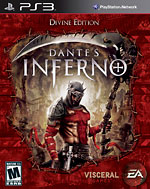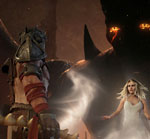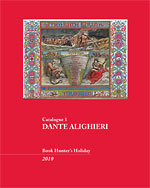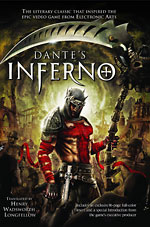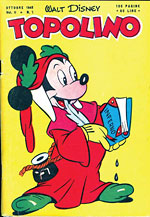Dante, Transformed
A book dealer’s role in the hottest new video game By Rebecca Rego Barry
Old books and video games might just be a match made in heaven. Last month, Electronic Arts/Visceral Games launched a game based on Dante’s Inferno, with an apt slogan to entice gamers, “Go to hell.” For those who make it there and back, a bonus documentary featuring rare Dante volumes awaits.
Chris Lowenstein, owner of Book Hunter’s Holiday in San Mateo, California, who had been working for years on a Dante catalogue, became involved in the project when she happened to meet Visceral Games executive producer Jonathan Knight one day while visiting her cousin, who works for EA, Knight gave her a sneak preview of the Inferno game, and they discussed their mutual interest in Dante. Months passed, and then Knight contacted Lowenstein about appearing on camera in a bonus feature documentary (called “Dante in History”) to talk about Dante and show off some of the illustrated editions she had been collecting.
As a former high school English teacher who taught Dante, Lowenstein was able to provide historical context for the game, which she described as “wildy different from the book.” She brought along some of her Dante editions and set them up on a rotating tray for some 360-degree shots. Filming at EA took an entire day. She joked, “this must be what a movie studio is like.”
For Lowenstein, the timing of the EA game was one of those rare, wonderful coincidences in the book world. She opened Book Hunter’s Holiday three years ago, after a career change. She had a small assortment of modern illustrated copies of Dante’s Divine Comedy that she used to help students understand the poem, and she used that as a springboard to form her first major collection. She remembered thinking, “I’m going to start collecting what I know, and what I know is Dante.”
She began acquiring antiquarian editions of Dante more seriously, with the idea of publishing her first catalogue entirely on the Italian poet. Since Dante’s work has a 700-year history, she narrowed her search by focusing on books published within the last 300 years, and only those that were illustrated, signed, or unusual in some way.
“I wanted to show that you can build a really interesting and meaningful collection even if you couldn’t afford to buy the incunabula,” Lowenstein said.
Book Hunter’s Holiday’s full-color catalogue containing 65 items was published last month. Lowenstein also provides a PDF version on her website, as an invitation to young collectors. “I’m really interested in the ways this can reach a younger audience,” she said. The video game also might reach a new generation of book collectors, even by indirect exposure, she added.
The EA game is rated M for mature audiences because of its violence and nudity—yes, Virgil, nudity. It will reach untold thousands of gamers, largely male and generally in the age group 18-35, according to Knight.
Knight too is interested in the crossover potential of games and books. Knight, who has a background in fine arts, was the driving force behind creating a game based on Dante’s epic.
“I chose Dante because I wanted to do a game about hell, so that was the first impulse … not just the imagined version, to do the medieval version of hell.” Such a game would, in an oblique way, show people what the medieval worldview and belief system was like, he added.
He acknowledged that the idea of making changes to a great work of literature to “shoehorn it into a video game may seem crazy,” but “it’s the nature of adapting from one medium to another.” The basic narrative remains the same—there are still nine circles of hell, and Dante battles his way through them to reclaim his beloved Beatrice. And while it is a bit of an experiment, Knight said he has heard from teachers that the game is sparking an interest in Dante. “The game project is getting people interested in Dante, and they’re actually picking up the book,” he said. “It’s piquing their interest.”
A glimpse at the official Dante’s Inferno website might well prove his point. EA has posted a full (and easy-reading) commentary on the poem, and the site’s community message boards are full of posts that mention Dante the author and quote lines of poetry, including a forum thread titled, “Some Rather Big Discrepancies Between Game and Poem” and another in which gamers/readers are analyzing the various translations of the poem’s first line.
Del Ray Books (imprint of Ballantine at Random House Publishing) issued a special EA-collaboration trade paperback of the Inferno with an appealing cover, an introduction written by Knight, and a 16-page, full-color art insert showcasing the characters and environments from the game. A set of six comic books published by DC Comics/WildStorm Productions and featuring the artwork of Diego Latorre is also now available.
Of course, that wouldn’t be the first Dante-inspired comic; Lowenstein offers a collection of Disney’s Dante from 1949, 1955, and 2006 in her catalogue.
From epic poem to video game to comic book to rare collectable (not to mention film, musical composition, and artwork), Dante’s Inferno has proven controversial, adaptable, and ever popular.









